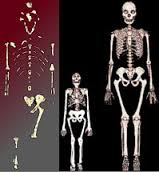Comparison of female skeletons / Australopithicus afarensis “LUCY” vs. Modern Woman (Homo sapiens sapiens)
The short skeleton is that of a female Astralopithecus afarensis dubbed ‘Lucy’ – a bipedal walker; 3′ 8″ tall; weight about 65 lbs. Her adult brain capacity was 400 cc.
The tall skeleton is that of a modern female, fully bipedal-able to run, about 5’4″ tall, 120 lbs. Adult brain capacity, 1200-1400 cc.
Due to the 3-D form and mechanics of the modern female pelvis, the maximum brain size of a human fetus at birth is 400 cc. In essence, modern human females give birth to an A. afarensis adult brain attached to an infant body only 20″ long. The close match in volume between the adult A. afarensis brain size and that of a human baby at birth is one of those “factoids” that rings bells in the human mind. Is it coincidence, or is there a connection? This question of “causal or coincidental” relationship between objects or events is one of the most vital questions in science. The “magical” human brain typically sees meaningful or causal connections where none exist.
Note: the condition of microcephaly (brain at birth in the 400cc range) when it is a developmental defect in modern humans, has been thought to be an “atavism” or throwback to archaic humans.
 We are fascinated by the fact that brain grows substantially after a human infant is born, but it is important to note that humans are born with very big brains in relation to the size of the infant body. By the age of puberty (12-13) the infant brain and body must grow, and learn to operate, an adult body. The rate and timing of growth of parts and systems in humans is highly differentiated from conception to adulthood. Becoming an adult is like “unfolding” a tightly packaged distorted blueprint.
We are fascinated by the fact that brain grows substantially after a human infant is born, but it is important to note that humans are born with very big brains in relation to the size of the infant body. By the age of puberty (12-13) the infant brain and body must grow, and learn to operate, an adult body. The rate and timing of growth of parts and systems in humans is highly differentiated from conception to adulthood. Becoming an adult is like “unfolding” a tightly packaged distorted blueprint.
_________________________________________________________________________________
Bipedal birth is over 3 million years old.
It is possible that the optimum ratio of fetus head circumference to pelvic inlet peaked with Homo erectus, and that increased birth difficulty (due to a narrow pelvis and partially blocked pelvic inlet) which characterizes Homo sapiens sapiens, is partly due to selection during human domestication. The variable head size of modern human infants also contributes to birth problems: premature birth (in the U.S.) has become common – does this indicate physical inadequacies – changes in the female skeleton, or is it simply a medical trend due to convenience of both medical staff and mothers? These are important questions for the health not only of infants, but for childhood development and long term health throughout life.
__________________________________________________________________________________________
The Olympics present an opportunity to note the range of body types associated with specific sports; it’s also difficult to make accurate observations from TV video, but, it seems pretty obvious that female (and male runners) have long “skinny” legs – little lower leg muscle, and narrow pelvis-hips. Typical for males, but how does this affect female reproduction, if at all? ). Some long distance runners appear to verge on anorexia, but have tremendous endurance. It does seem that Homo sapiens early environments favored “runners” but this does present a problem for pregnant women, children, and women caring for children and elderly individuals.
